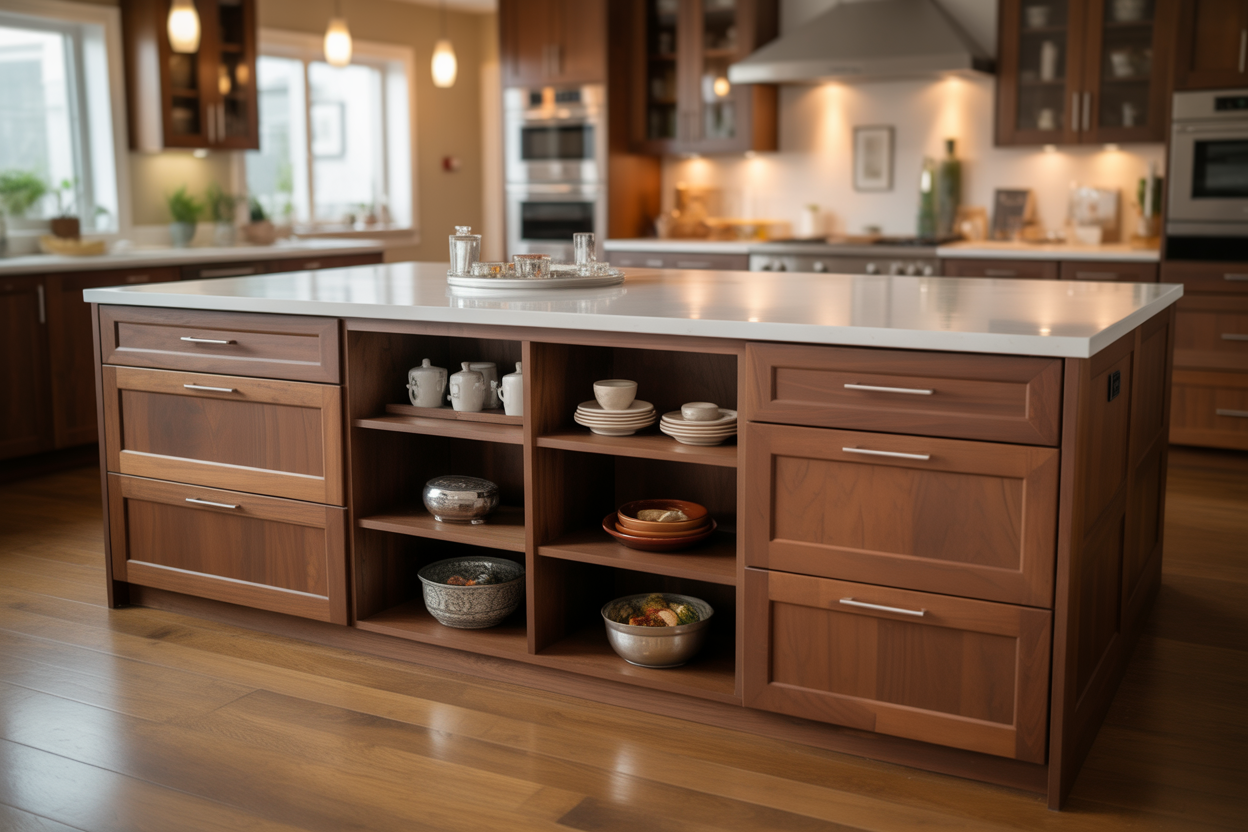
The kitchen island has evolved from a simple prep surface into the multitasking heart of family life—a command center where homework happens alongside meal prep and morning coffee rituals collide with afternoon snack raids.
In order to come up with the very specific design ideas, we create most designs with the assistance of state-of-the-art AI interior design software.
For busy households, double-sided storage transforms this central fixture into what I call “democratic design,” where access from multiple angles creates an intuitive flow that accommodates several family members simultaneously. This architectural psychology reduces bottlenecks during peak kitchen hours while fostering the collaborative energy that makes a house feel like home.
Kitchen Island with Double-Sided Open Shelving
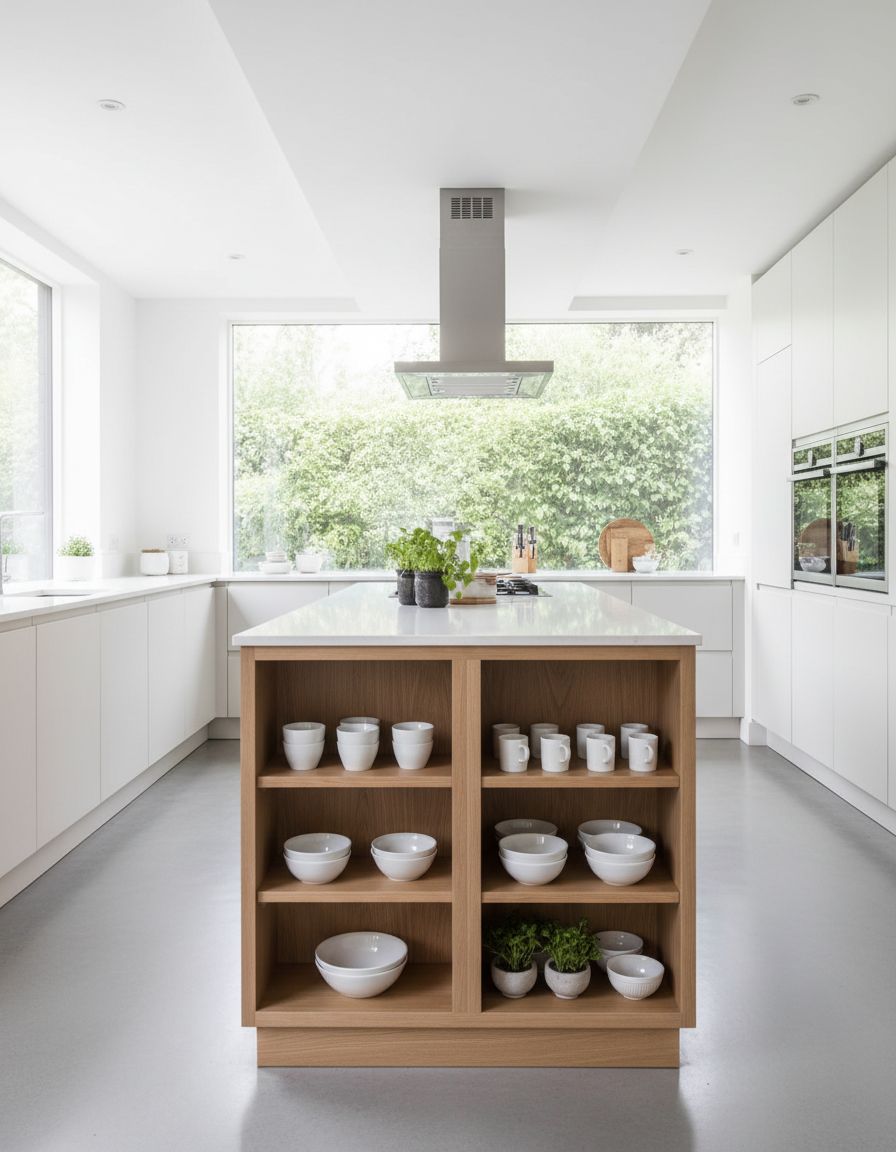
Open shelving on both sides creates what I describe as “transparent functionality”—a design approach that turns storage into display while maintaining accessibility from cooking and dining zones. This configuration works brilliantly for families who embrace a curated aesthetic, showcasing everyday dishes, cookbooks, and decorative bowls that add personality without sacrificing practicality.
The psychological benefit lies in visual clarity; when items remain visible, family members naturally maintain organization, and the kitchen develops a lived-in warmth that closed cabinets simply cannot achieve.
Kitchen Island with Double-Sided Deep Drawers
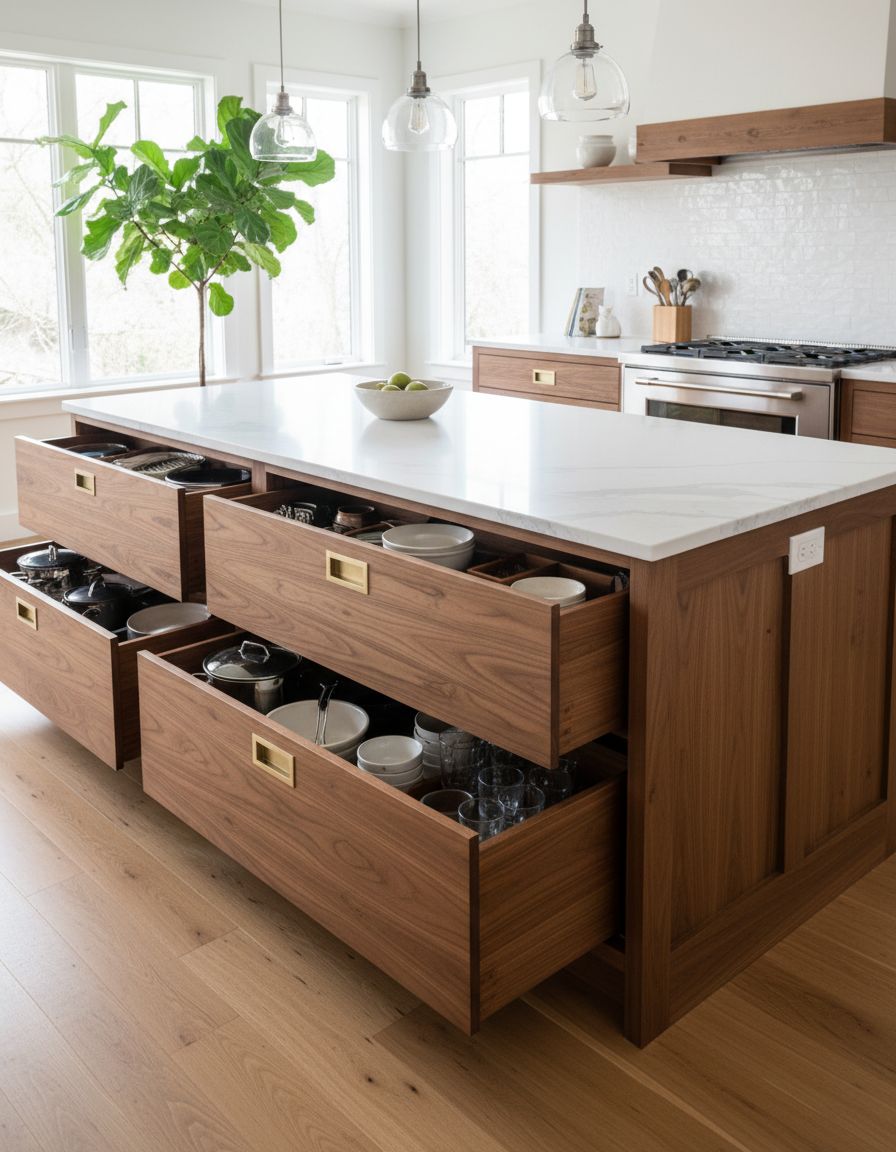
Deep drawers accessible from opposing sides embody the principle of “strategic concealment,” hiding bulky items like mixing bowls, small appliances, and baking sheets while keeping them within arm’s reach from multiple work zones.
This design particularly resonates with families managing visual clutter anxiety—everything has a designated home, yet retrieval remains effortless during the chaos of dinner preparation. The tactile satisfaction of smoothly gliding drawers also creates a subtle luxury experience that elevates daily routines into mindful moments of domestic efficiency.
Kitchen Island with Double-Sided Cabinet Doors

Traditional cabinet doors on both island faces offer what I term “controlled accessibility,” providing enclosed storage that maintains a streamlined appearance while serving both kitchen and dining areas. This symmetrical approach appeals to families who value visual cohesion and flexibility in storing everything from dishware to craft supplies.
The psychological comfort of closed storage reduces mental overwhelm in open-plan spaces, allowing the kitchen to transition seamlessly from functional workspace to entertaining zone without exposing the inevitable accumulation of family life.
Kitchen Island with Double-Sided Pull-Out Baskets
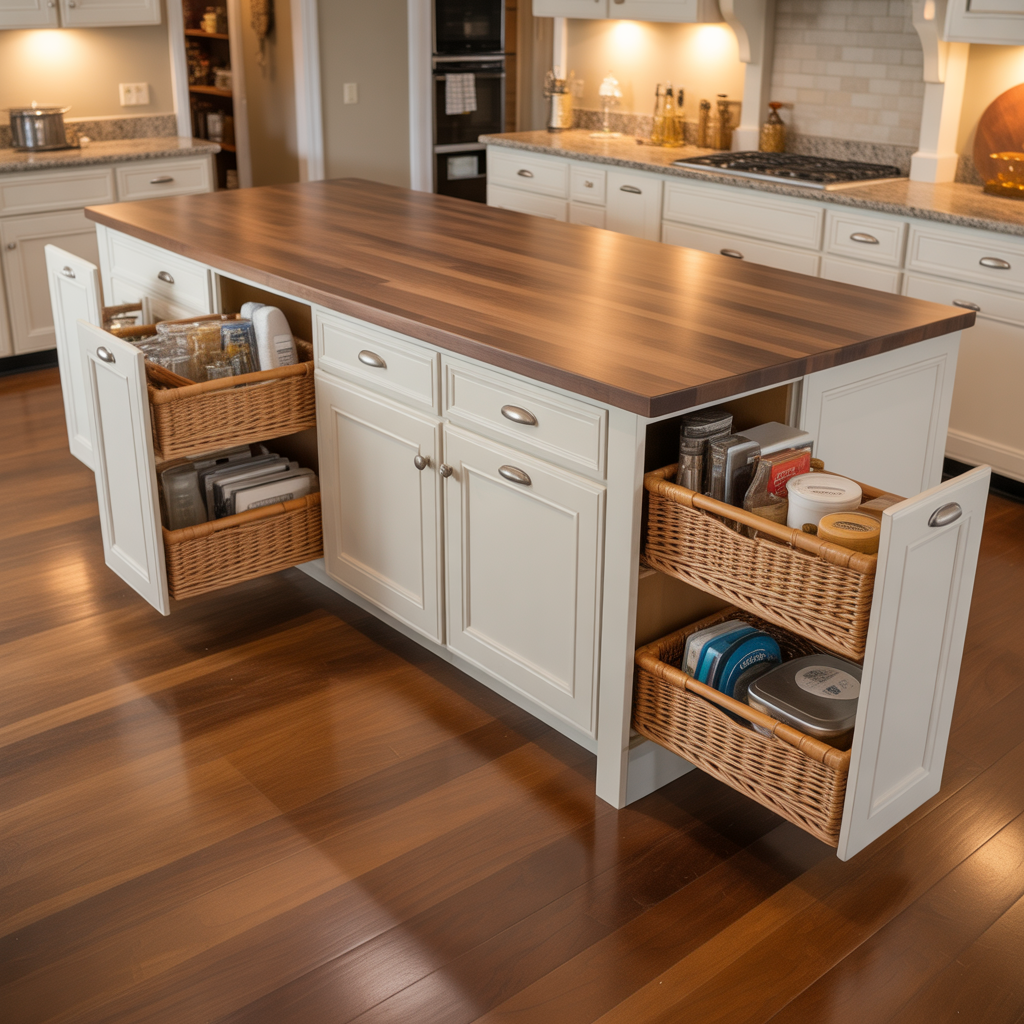
Wire or woven pull-out baskets create “transitional storage”—a hybrid between open and closed systems that offers visibility with containment. These baskets excel at organizing produce, snacks, lunch-making supplies, and kids’ items that need frequent access from both the cooking and homework sides of the island.
The ventilation benefits keep fruits and vegetables fresher, while the casual aesthetic softens the kitchen’s formality, creating an approachable atmosphere that encourages family participation in meal preparation and cleanup routines.
Kitchen Island with Double-Sided Glass-Front Storage
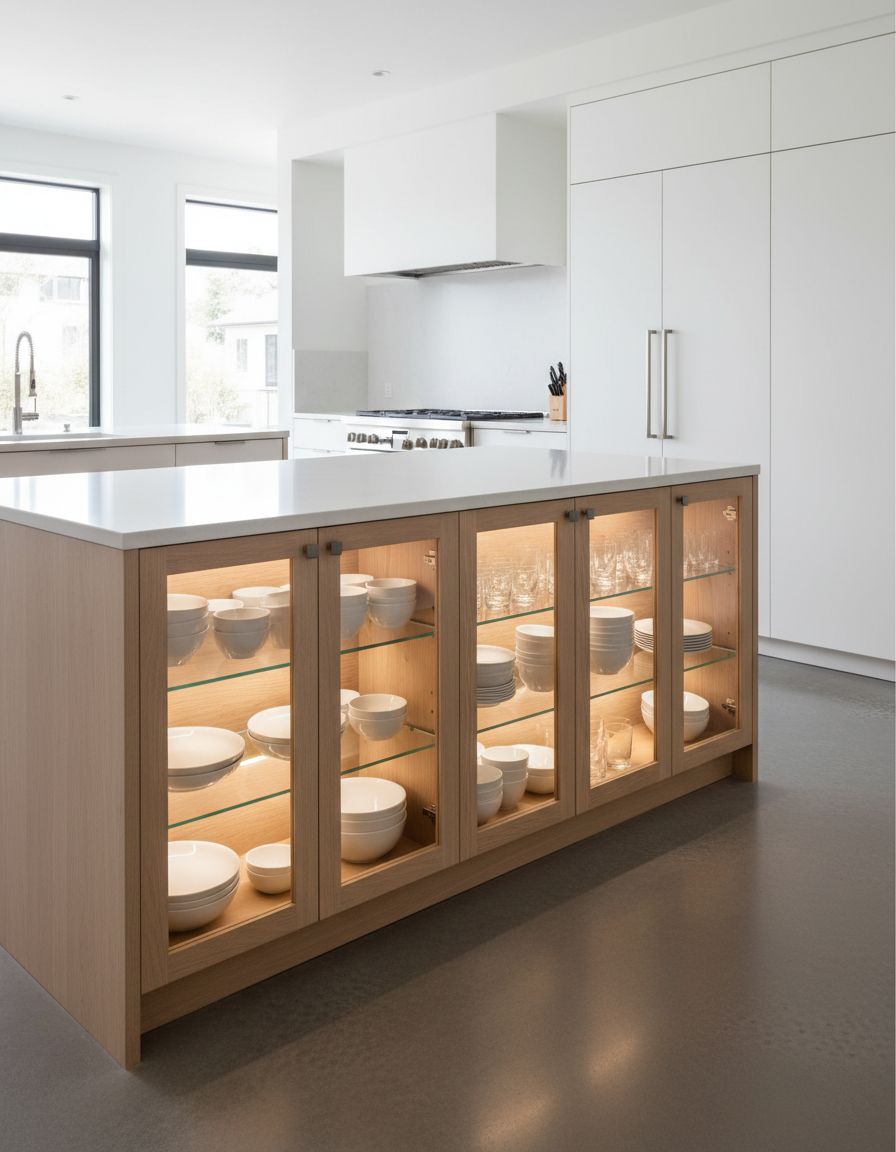
Glass-fronted cabinets on dual sides introduce what I call “curated transparency,” allowing families to display cherished items while maintaining dust protection and visual order. This design works exceptionally well for glassware collections, heirloom china, or colorful dishware that adds personality to the kitchen landscape.
The reflective quality of glass also amplifies natural light, creating a sense of spaciousness while the display element encourages mindful curation—families become more intentional about what occupies this visible real estate.
Kitchen Island with Double-Sided Breakfast Bar Storage
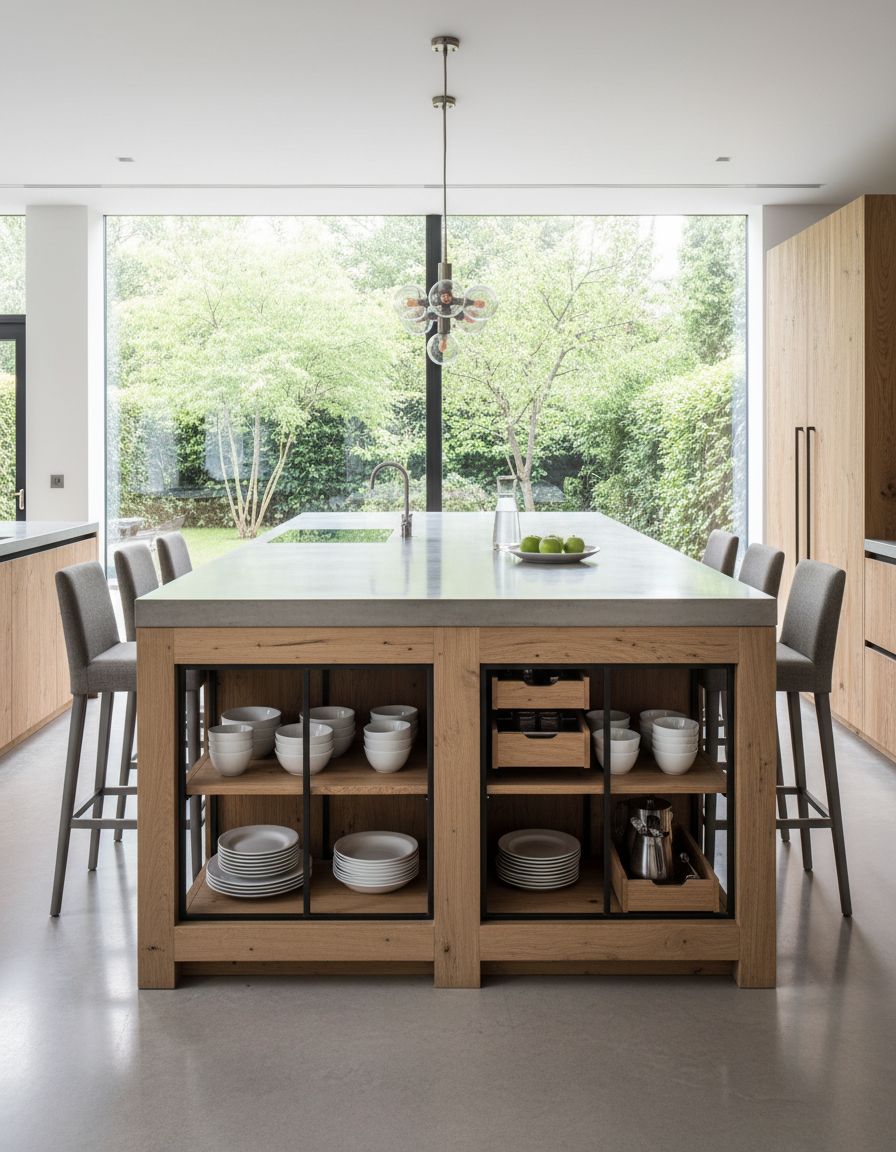
Integrating storage beneath an extended breakfast bar creates “layered functionality” where seating and organization coexist without compromise. Shelving or cabinets facing the seating area provide easy access to breakfast essentials, napkins, and placemats, while the kitchen-facing side accommodates cooking implements.
This configuration transforms the island into a self-sufficient breakfast station, reducing morning traffic to perimeter cabinets and creating what I describe as “zoned independence”—family members can serve themselves without disrupting the primary cook’s workflow.
Kitchen Island with Double-Sided Spice Rack Storage

Dedicated spice storage on opposing island sides represents “culinary centralization,” placing seasonings at the epicenter of cooking activity rather than relegating them to distant cabinets. Narrow pull-out racks or stepped shelving keep bottles visible and accessible, dramatically reducing meal prep time while encouraging more adventurous cooking.
The psychological impact of seeing a well-organized spice collection often inspires creativity, transforming routine dinners into opportunities for experimentation. This arrangement particularly benefits multi-cook households where different family members approach the island from various angles.
Kitchen Island with Double-Sided Appliance Garage Storage
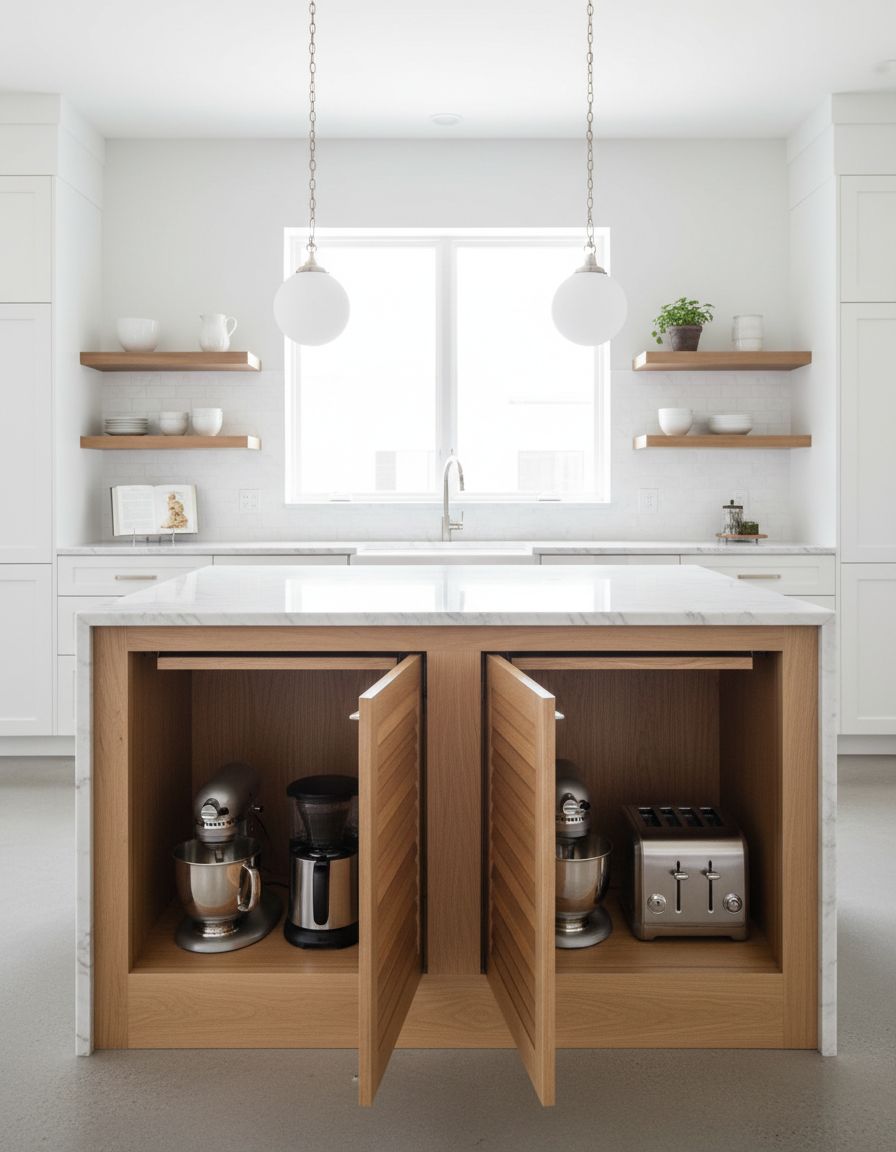
Appliance garages on both island faces create “on-demand convenience,” housing frequently used small appliances like blenders, coffee grinders, or stand mixers in retractable compartments. This design maintains countertop clarity while eliminating the inefficiency of retrieving heavy items from overhead or base cabinets.
The tambour doors or lift-up panels provide quick access that encourages appliance use rather than discouraging it through inconvenience. For busy families, this arrangement supports healthier eating habits by making food preparation tools immediately available when motivation strikes.
Kitchen Island with Double-Sided Wine Rack Storage
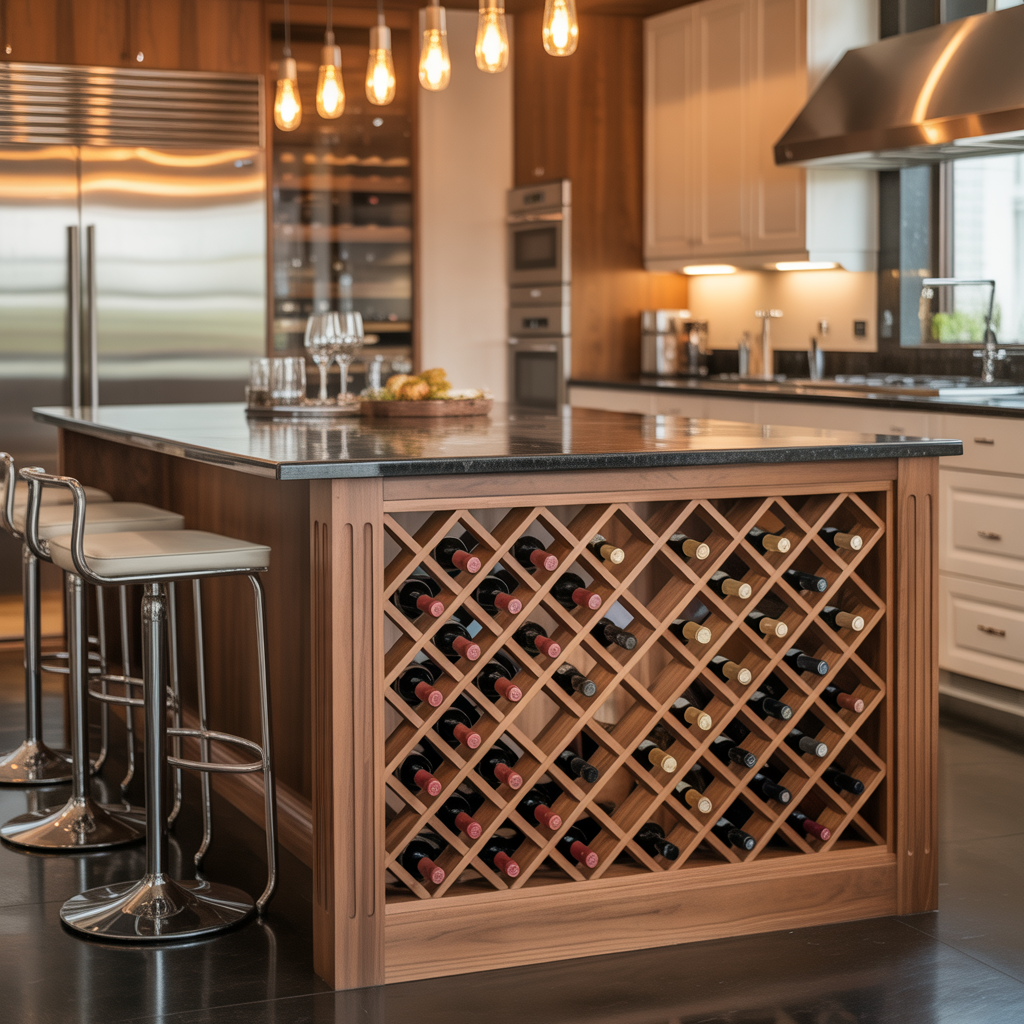
Integrated wine storage accessible from multiple sides introduces “social symmetry” into the kitchen island, creating natural gathering points during entertaining while maintaining functionality during everyday use. Whether designed as horizontal bottle cradles or vertical slots, this feature elevates the island into a statement piece that reflects lifestyle priorities.
The diagonal bottle display adds architectural interest, breaking up flat cabinet expanses with dimensional rhythm. For families who enjoy cooking with wine, having bottles centrally located streamlines both culinary and social aspects of kitchen life.
Kitchen Island with Double-Sided Cookbook Storage Nooks
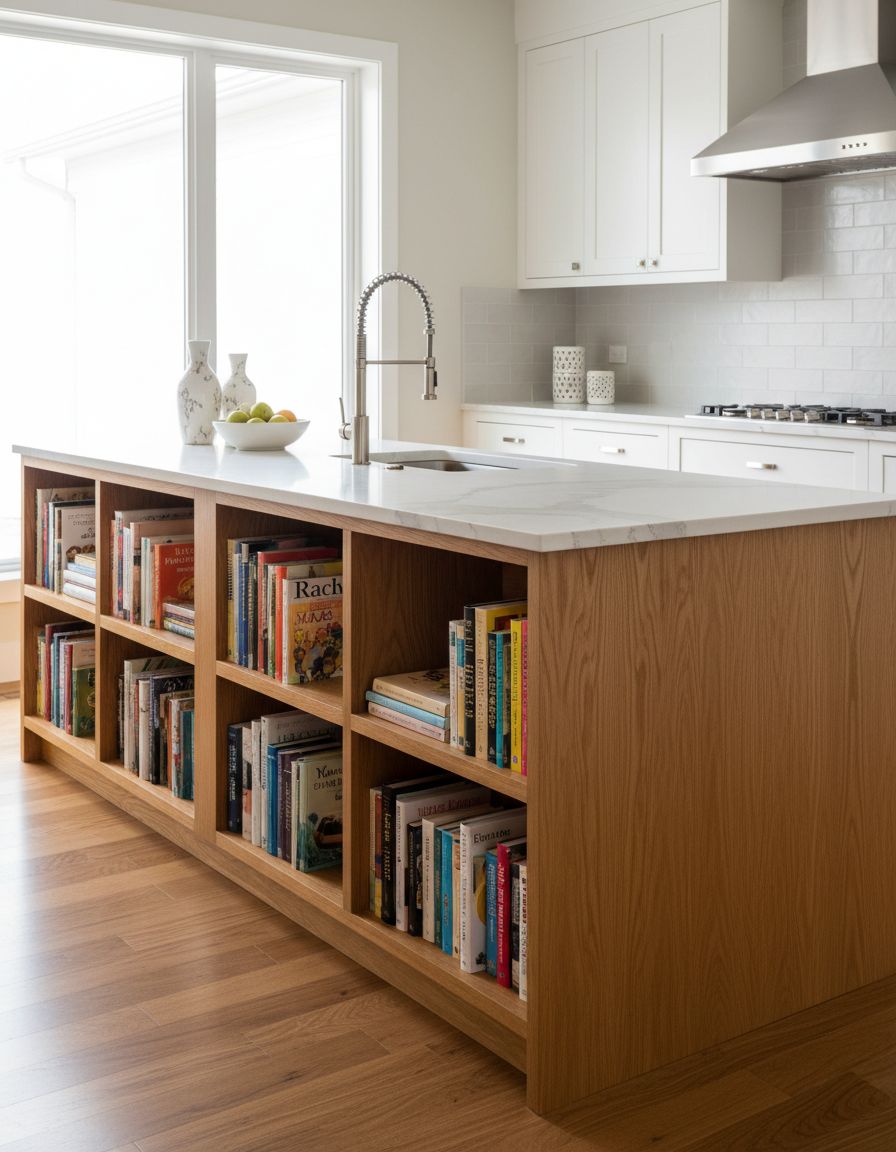
Dedicated cookbook compartments on both island sides establish what I call “reference accessibility,” positioning recipe inspiration at the heart of cooking activity. Vertical slots or small shelving units keep books upright and visible, while tablet-sized nooks accommodate modern digital recipe displays.
This design honors the ritual of cooking from beloved recipes while acknowledging contemporary technology integration. The presence of cookbooks adds warmth and personality, signaling that this kitchen values culinary tradition alongside efficiency—a psychological touchstone that transforms cooking from chore to cherished practice.
Kitchen Island with Double-Sided Utensil Drawer Storage

Mirrored utensil drawer configurations on opposing sides create “tool redundancy” that eliminates the constant drawer-opening dance when multiple family members cook simultaneously. Custom dividers organize spatulas, whisks, and serving spoons logically, with duplicates of frequently used items on both sides.
This thoughtful redundancy reduces friction during collaborative cooking sessions and teaches children organizational skills through consistent placement. The immediate availability of proper tools also encourages proper technique and safety, particularly when young cooks are learning knife skills or heat management.
Kitchen Island with Double-Sided Pantry Storage

Full-height pantry columns integrated into the island structure create “vertical abundance,” maximizing storage capacity while maintaining accessibility from kitchen and dining perspectives. Pull-out shelving systems or swing-out units bring rear items forward, eliminating the frustration of forgotten ingredients.
This centralized pantry approach keeps frequently used items within the primary work zone, reducing steps and supporting the principle of efficient kitchen triangles. For large families, this configuration prevents the single-file bottleneck that occurs when everyone needs simultaneous access to perimeter pantries.
Kitchen Island with Double-Sided Plate Rack Storage
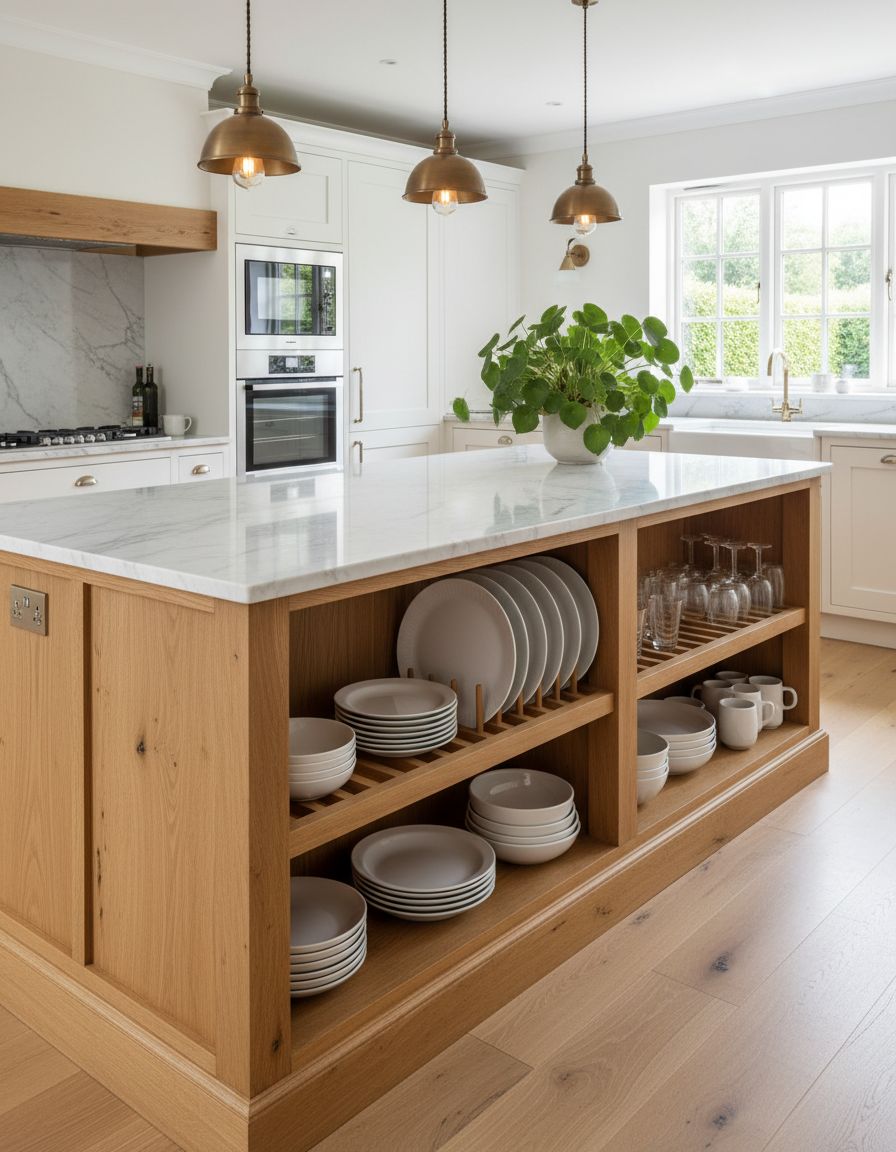
Vertical plate racks on dual island faces combine “display with readiness,” keeping everyday dishware accessible while adding architectural texture through repetitive linear elements. This European-inspired approach to dish storage promotes air drying after hand washing while eliminating the stacking instability of traditional cabinets.
The visible plate edges create a rhythmic visual pattern that adds sophistication, and the arrangement encourages families to invest in cohesive dishware that deserves display. This design particularly suits families who value sustainable practices like hand washing over constant dishwasher cycles.
Kitchen Island with Double-Sided Trash Bin Storage
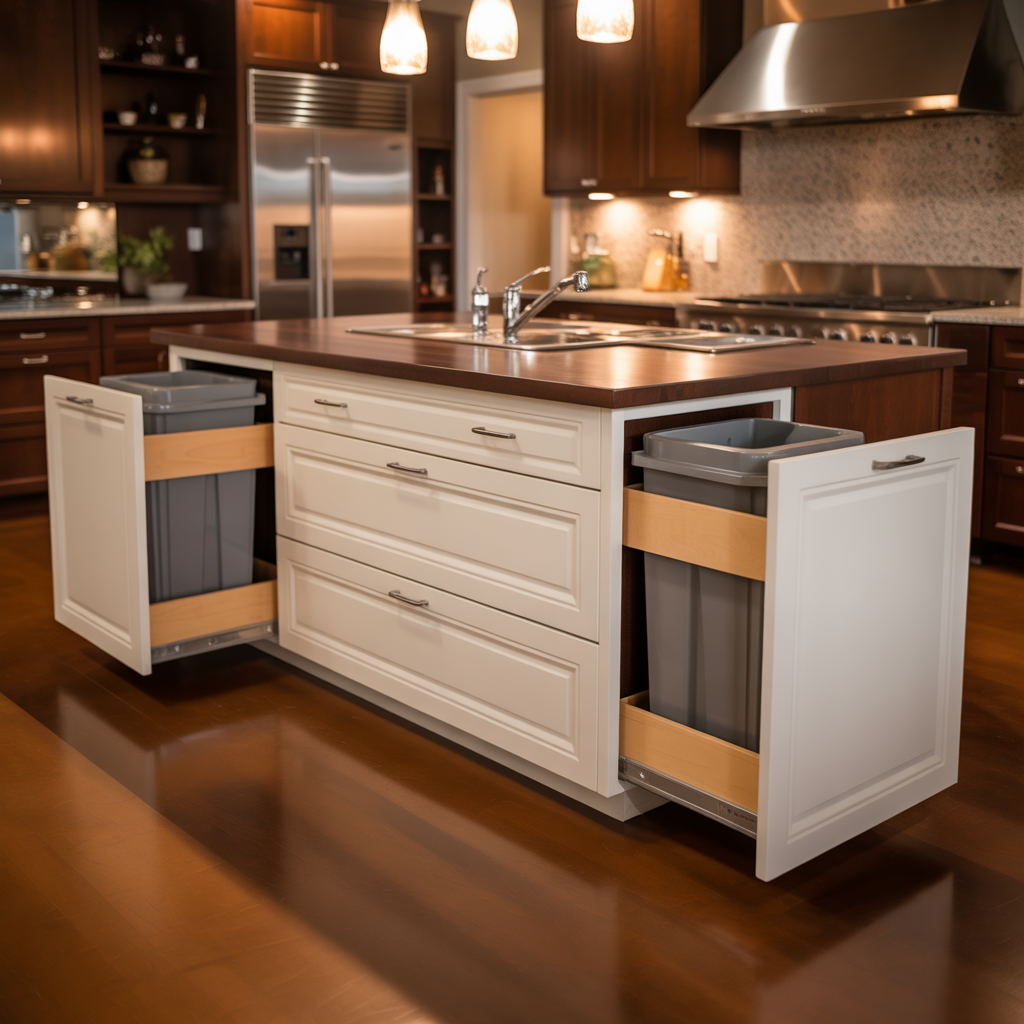
Concealed waste and recycling bins accessible from multiple sides represent “functional discretion,” hiding necessary but unattractive elements while maintaining convenience during food prep and cleanup. Pull-out systems with separate compartments support eco-conscious sorting habits, making sustainable practices effortless rather than inconvenient.
Positioning waste disposal centrally reduces the tracked debris that occurs when crossing the kitchen repeatedly with scraps. This configuration also keeps bins away from primary traffic patterns, reducing accidental openings while accommodating family members approaching from different angles during collaborative cooking or cleaning efforts.
Kitchen Island with Double-Sided Divided Drawer Storage
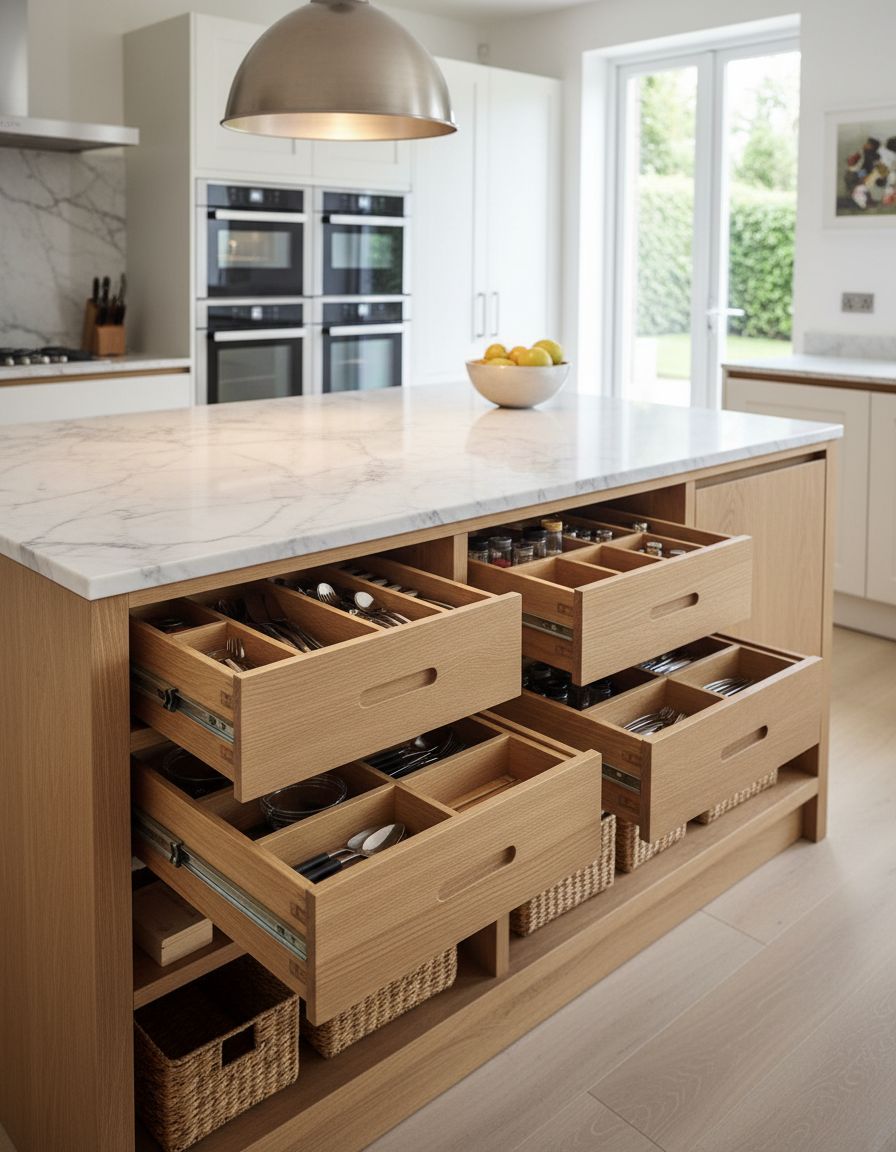
Customized drawer dividers on both island faces create “categorical precision,” establishing designated homes for everything from baking supplies to school lunch components. Adjustable organizers adapt as family needs evolve, accommodating toddler snack pouches that eventually become teenage protein bar collections. This organizational clarity reduces decision fatigue—family members know exactly where items belong and where to find them—supporting the mental load management that busy parents desperately need. The visual order of well-divided drawers also provides subtle psychological relief in the midst of domestic chaos.
Kitchen Island with Double-Sided Hidden Storage Compartments
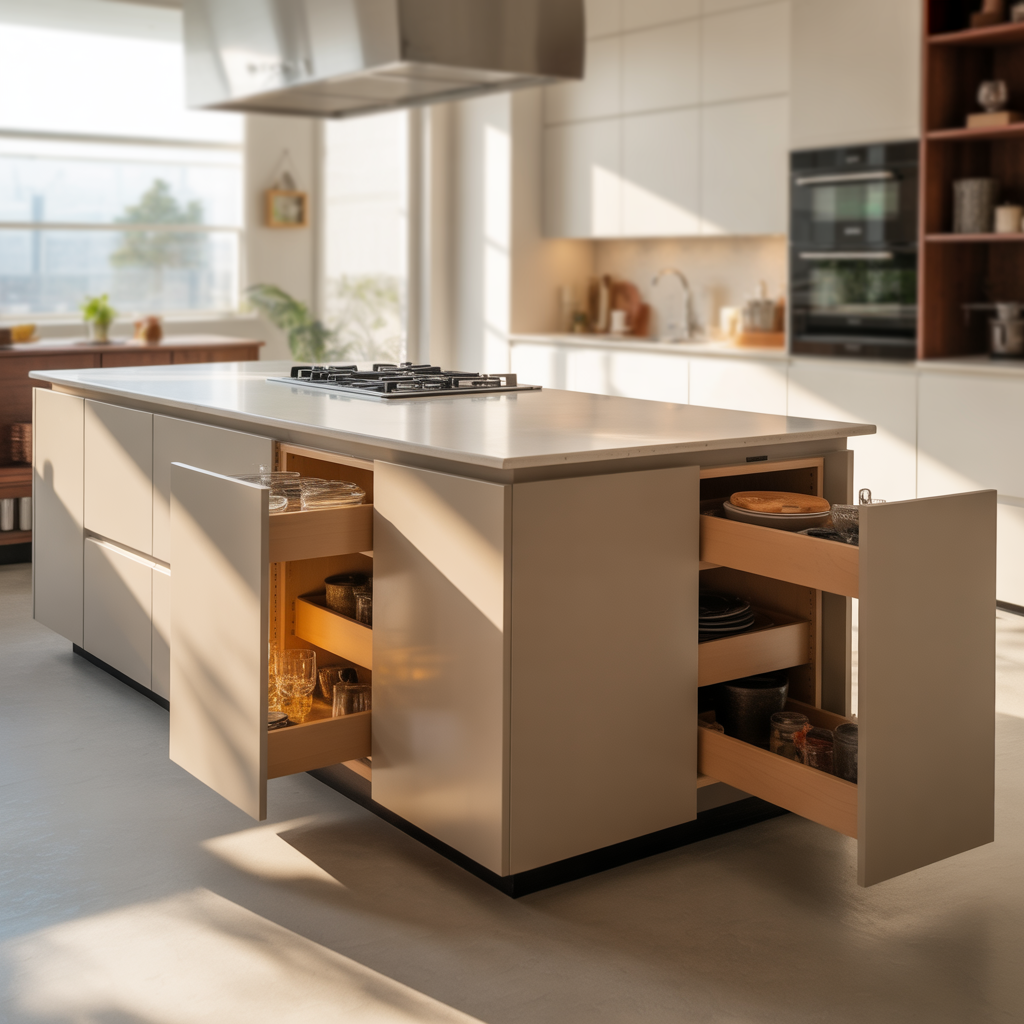
Concealed compartments behind false drawer fronts or pop-up panels introduce “discovered functionality,” surprising users with clever storage solutions that maintain the island’s clean aesthetic. These secret spaces might hide charging stations, small valuables, or medications that require secure storage away from children.
The element of intentional design creates daily moments of delight while serving practical purposes. This approach resonates with families managing diverse storage needs within limited square footage, proving that thoughtful design can accommodate complexity without visual chaos or compromised style.
Kitchen Island with Double-Sided Kid-Accessible Storage
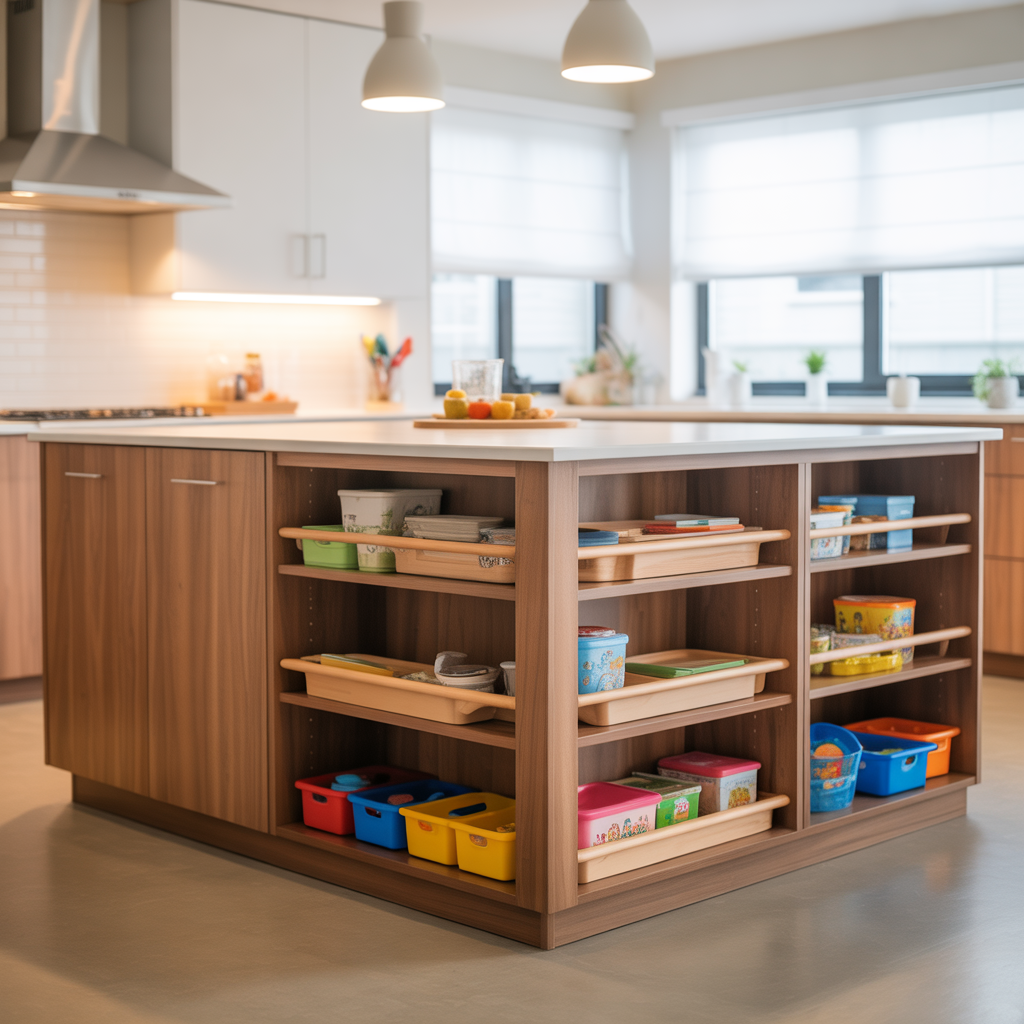
Lower cabinets and drawers designed specifically for children’s reach foster “independent capability,” encouraging self-sufficiency in snack retrieval, dish return, and meal participation. This democratic design approach might include plastic dishware, healthy snacks, craft supplies, and homework materials stored at appropriate heights.
The psychological benefits extend beyond convenience—children develop ownership of kitchen responsibilities and spatial awareness while parents reduce the constant requests for help. Color-coded systems or picture labels further support literacy development and organizational skills that extend far beyond the kitchen environment.
Kitchen Island with Double-Sided Towel Bar Storage
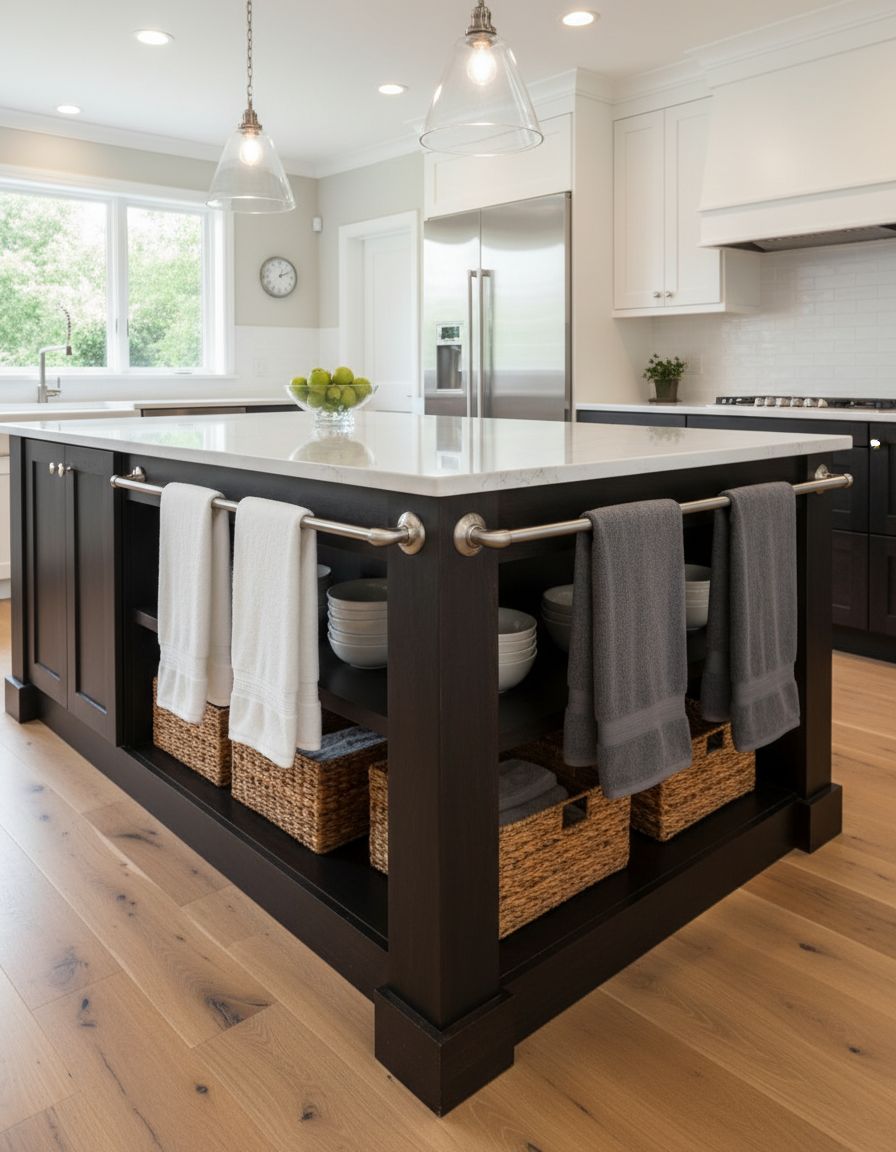
Integrated towel bars on opposing island faces provide “distributed utility,” keeping dish towels, hand towels, and pot holders accessible from both cooking and cleaning zones. This simple addition prevents the single-towel bottleneck during collaborative cooking while maintaining the tidy appearance that freestanding towel placement often disrupts.
Warming drawer integration adds luxury, providing heated towels for bread baskets while keeping kitchen textiles dry and fresh. The deliberate placement of towel bars also establishes visual rhythm and breaks up expansive cabinet faces with functional hardware that serves daily needs.
Kitchen Island with Double-Sided Charging Station Storage
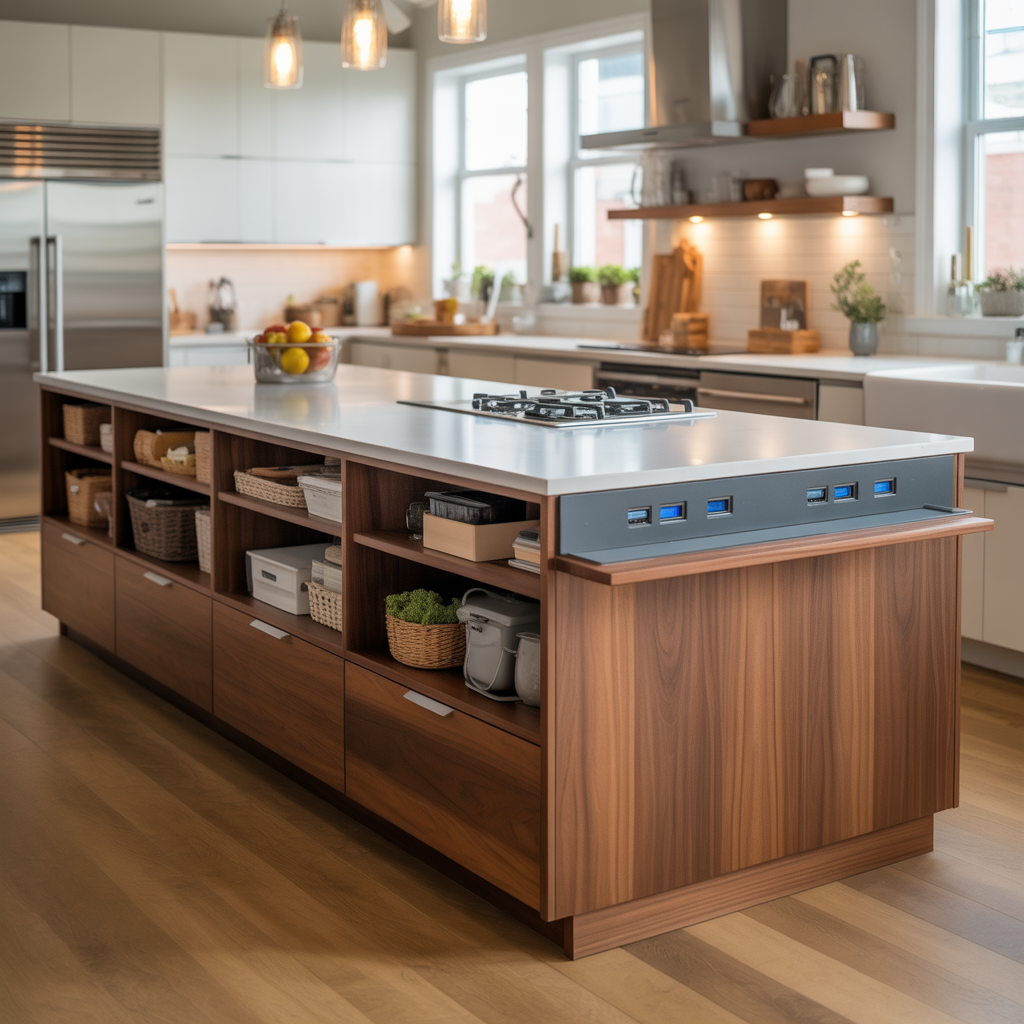
Built-in charging drawers or outlets on multiple island sides acknowledge modern reality—devices require power where families congregate. These stations prevent cable clutter while creating designated technology zones that keep phones and tablets accessible but contained. The drawer-based approach conceals charging devices during meals or entertaining, supporting intentional device-free family time when desired.
This feature particularly benefits homework supervision, recipe following, and the modern practice of photographing meals, providing power exactly where these activities naturally occur without extension cords disrupting the kitchen’s aesthetic flow.
Kitchen Island with Double-Sided Corner Storage Solutions
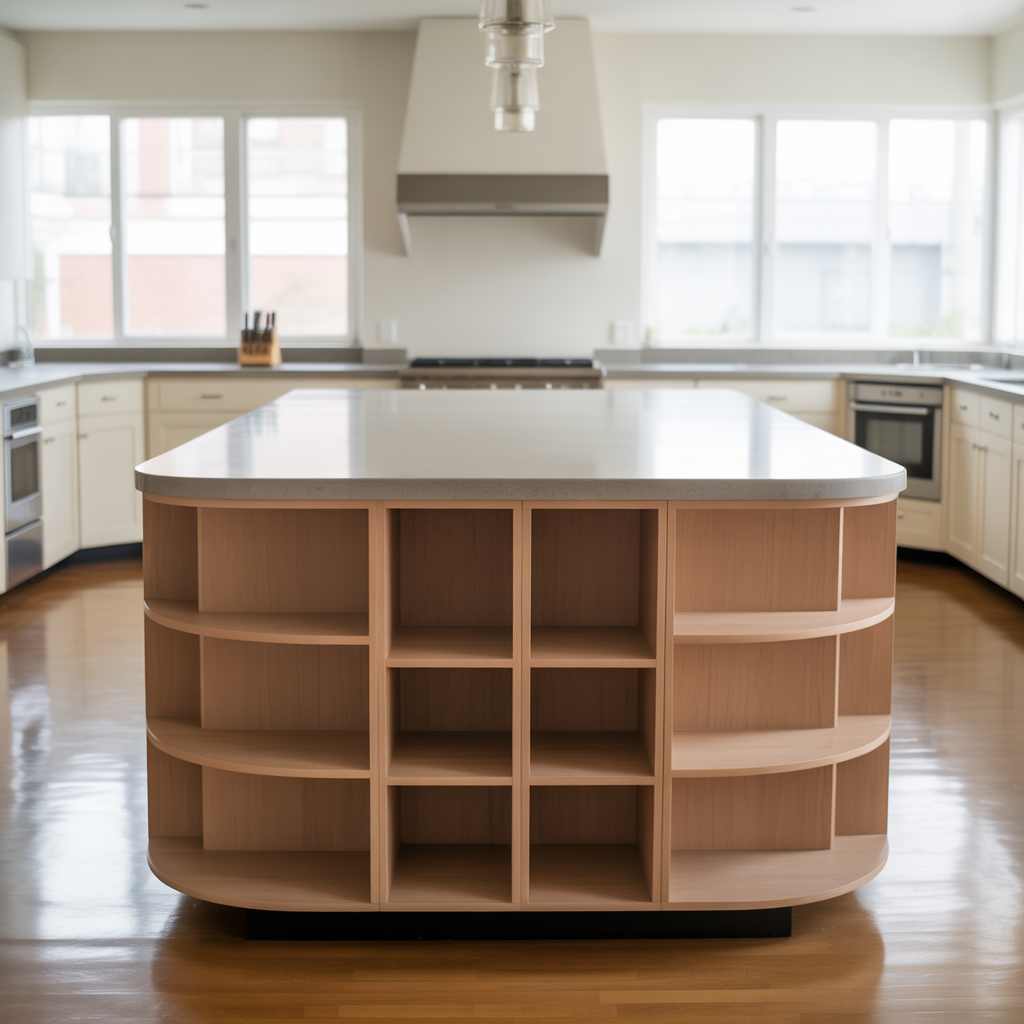
Lazy Susans or pull-out corner units maximize the typically wasted space where island and perimeter cabinetry meet, creating “recovered real estate” through clever mechanical solutions. These rotating or sliding systems make awkward corners as accessible as straight shelving, accommodating bulky items or specialized equipment that defies standard storage.
The satisfying mechanism of corner solutions adds a tactile pleasure to daily kitchen use while demonstrating that thoughtful design respects every cubic inch. For space-constrained kitchens, optimizing corners can add significant capacity without expanding the island’s footprint.
Kitchen Island with Double-Sided Mix Material Storage
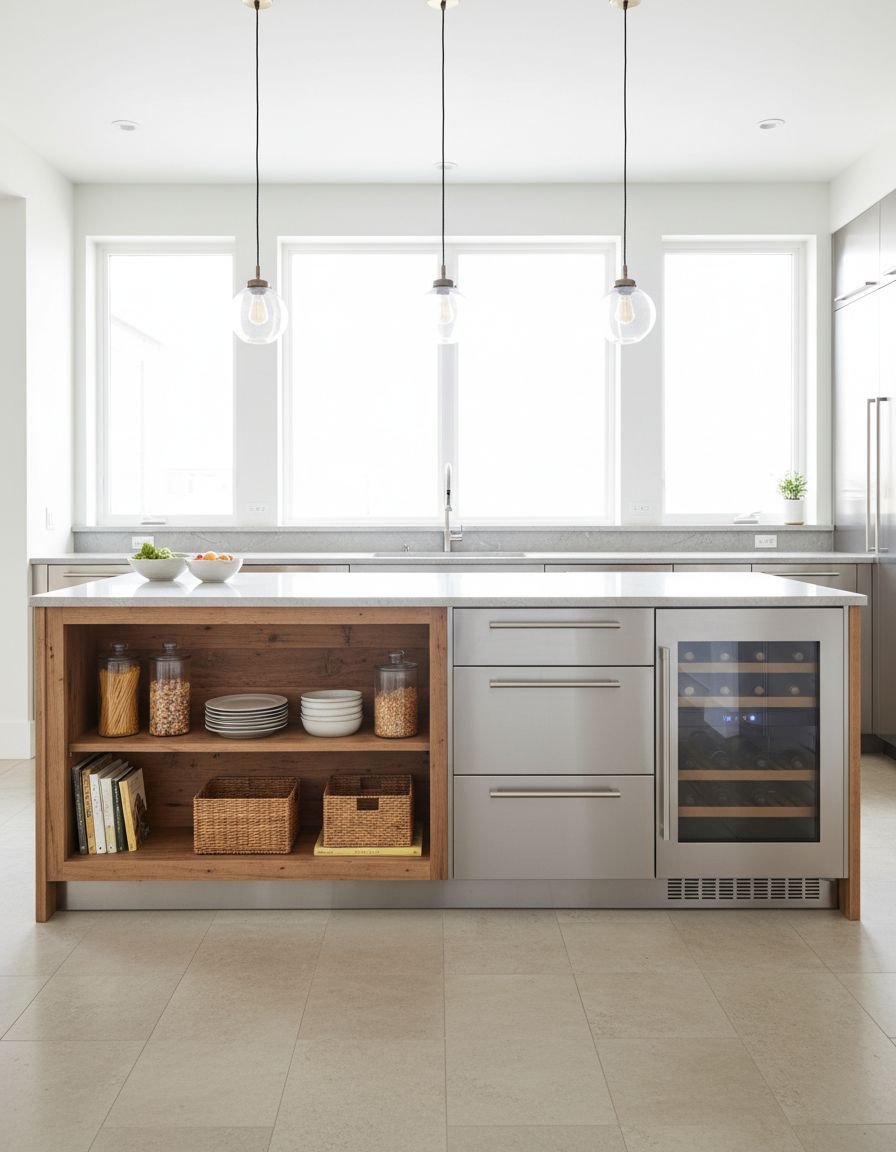
Combining wood, metal, glass, and acrylic storage elements on opposing island faces creates “textural dialogue,” adding visual complexity that prevents the monotony of uniform cabinetry. This approach might pair solid wood cabinets on the cooking side with open metal shelving on the dining side, balancing enclosed functionality with decorative display.
The material variety serves psychological needs for visual stimulation while allowing different storage types to serve their optimal purposes. This eclectic yet intentional mixing reflects contemporary design philosophy that values curated imperfection over sterile matchy-matchy uniformity.
Kitchen Island with Double-Sided Modular Storage Systems
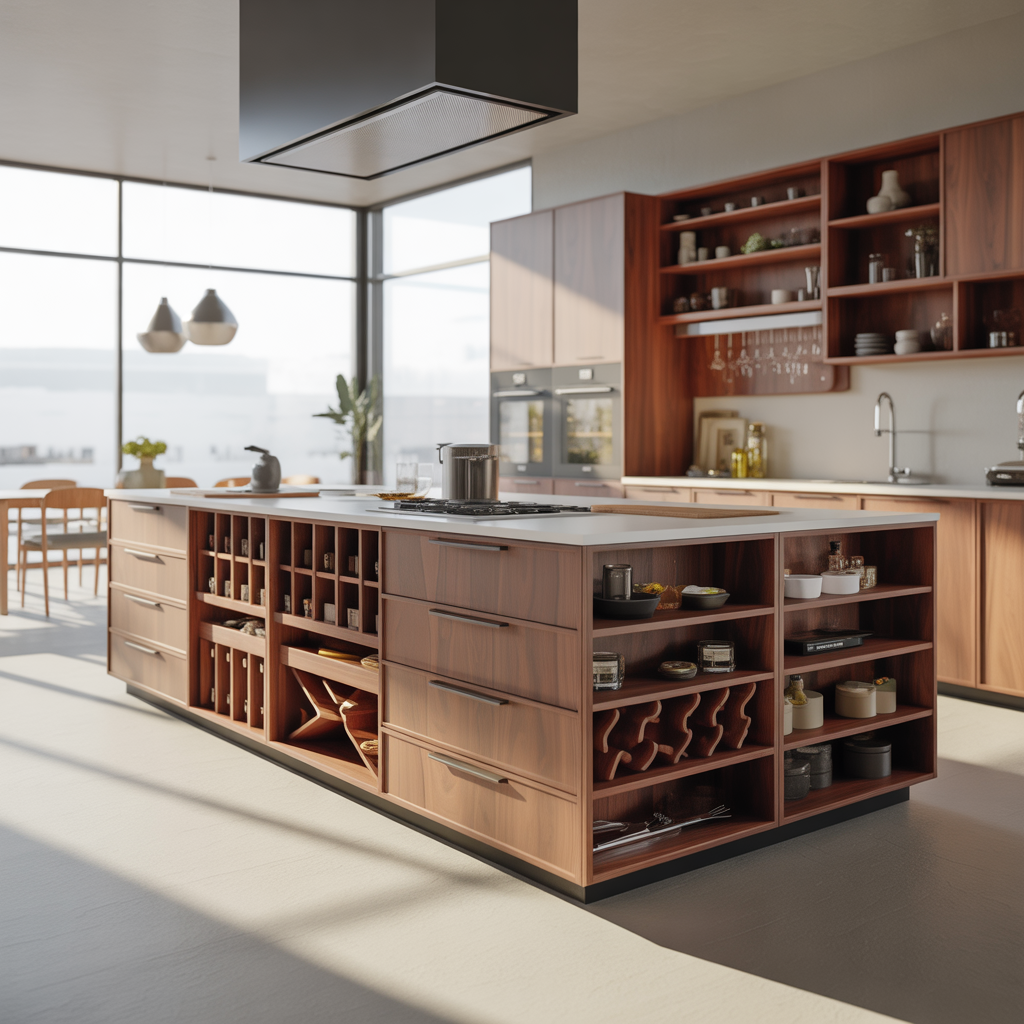
Reconfigurable storage components on both island faces provide “evolutionary design,” adapting as family composition, cooking habits, and storage needs transform over time. Interchangeable drawer inserts, adjustable shelving, and removable dividers accommodate the shift from baby bottle organization to teenage snack stations without requiring renovation.
This forward-thinking approach respects both financial investment and environmental responsibility, reducing waste while maintaining relevance. The flexibility also empowers families to experiment with organizational systems, discovering optimal arrangements through lived experience rather than hoping initial choices prove eternally adequate.






